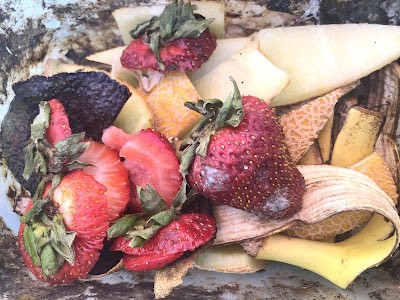
New rules mean rethinking which compost bin to use

|
|
Now there's a breakfast fit for worms: Berry stems,
melon rinds, banana peel and avocado skin. If you
are not a vermicomposter, all this can go in a regular
compost bin or into the organic waste collection can.
(Photo: Kathy Morrison)
|
Here's the scenario I imagine in my kitchen tomorrow as the state's new organic waste law goes into effect:
Me: "OK, the worms certainly get the melon rinds, the strawberry stems, the carrot peelings and the wilty spinach."
Other Me: "Wait, the carrot peelings and the spinach should be frozen with the onion ends to make vegetable broth."
Me: "Oh, right. And the worms don't like onions. Or citrus. So my compost bin at the community garden should get the moldy lemon, along with the dried-out garlic cloves, the corn husks and the cobs."
Other Me: "But corn cobs never break down fast enough in that compost bin. You really should chop things up better and turn them more often."
Me: "Uh, thanks for making me feel guilty about not turning my compost. But here's a solution: The corn cobs now can go into the green waste, I mean Organic Waste, container. Along with the dead flowers from that vase, that rock-hard cheddar cheese, the super-stale leftover crackers and the rest of the hummus I forgot about until it turned moldy."
Other Me: "Well, you COULD grind up the crackers to bread chicken. But storage is a problem when the freezer's so full. OK, just be sure to also throw in the used tea bags -- so glad we like a brand without staples or tags. And while you're at it, round up any wine corks (natural, not plastic) and toss those in, too."
Me: "Wine corks, really? OK, got a few of those."
Other Me: "The skin from last night's grilled fish, too. And the paper towel you used to dry the fish before seasoning it."
Me: "Wow, that bin's going to be stinky. I'll put some newspaper in the bottom, and cover up all this stuff with the stems I cut off my cured garlic crop."
Other Me: "Fight stinky with stinky! Good idea. By the way, don't forget to peel the sticker off the melon rind. Worms don't like plastic."
And ... scene!
Yes, it's going to take even compost veterans a bit of adjustment. But we can do it. The planet's worth it.
For more information on complying with the new law, check out these sites for Sacramento County residents, depending on where you live:
-- Folsom
-- Elk Grove
-- County of Sacramento (all unincorporated areas)
And if you'd like to know more about composting at home , especially worm composting , the links take you to great information from the UCCE Sacramento County master gardeners. Then during Harvest Day, on Aug. 6, come check out the compost set-up at the Fair Oaks Horticulture Center. Learn to keep all that rich, soil-building compost for yourself!
Comments
0 comments have been posted.Sacramento Digs Gardening to your inbox.
Food in My Back Yard Series
April 22: Should you stock up on fertilizer? (Yes!)
April 15: Grow culinary herbs in containers
April 8: When to plant summer vegetables
April 1: Don't be fooled by these garden myths
March 25: Fertilizer tips: How to 'feed' your vegetables for healthy growth
March 18: Time to give vegetable seedlings some more space
March 11: Ways to win the fight against weeds
March 4: Potatoes from the garden
Feb. 25: Plant a fruit tree now -- for later
Feb. 18: How to squeeze more food into less space
Feb. 11: When to plant? Consider staggering your transplants
Feb. 4: Starting in seed starting
Sites We Like
Garden Checklist for week of April 27
Once the clouds clear, get to work. Spring growth is in high gear.
* Set out tomato, pepper and eggplant transplants.
* From seed, plant beans, beets, cantaloupes, carrots, corn, cucumbers, melons, pumpkins, radishes and squash. Plant onion sets.
* In the flower garden, plant seeds for asters, cosmos, celosia, marigolds, salvia, sunflowers and zinnias. Transplant petunias, zinnias, geraniums and other summer bloomers.
* Plant perennials and dahlia tubers for summer bloom. Late April is about the last chance to plant summer bulbs, such as gladiolus and tuberous begonias.
* Transplant lettuce and cabbage seedlings.
* Weed, weed, weed! Don’t let unwanted plants go to seed.
* April is the last chance to plant citrus trees such as dwarf orange, lemon and kumquat. These trees also look good in landscaping and provide fresh fruit in winter.
* Feed citrus trees with a low dose of balanced fertilizer (such as 10-10-10) during bloom to help set fruit. Keep an eye out for ants.
* Apply slow-release fertilizer to the lawn.
* Thoroughly clean debris from the bottom of outdoor ponds or fountains.
* Start thinning fruit that's formed on apple and stone fruit trees -- you'll get larger fruit at harvest (and avoid limb breakage) if some is thinned now. The UC recommendation is to thin fruit when it is about 3/4 of an inch in diameter. Peaches and nectarines should be thinned to about 6 inches apart; smaller fruit such as plums and pluots can be about 4 inches apart. Apricots can be left at 3 inches apart. Apples and pears should be thinned to one fruit per cluster of flowers, 6 to 8 inches apart.
* Azaleas and camellias looking a little yellow? If leaves are turning yellow between the veins, give them a boost with chelated iron.
* Trim dead flowers but not leaves from spring-flowering bulbs such as daffodils and tulips. Those leaves gather energy to create next year's flowers. Also, give the bulbs a fertilizer boost after bloom.
* Pinch chrysanthemums back to 12 inches for fall flowers. Cut old stems to the ground.
* Mulch around plants to conserve moisture and control weeds.